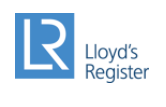Since 2016, London-based engineering, technical, and business services firm Lloyd’s Register (LR) and research and technology organization The Welding Institute (TWI) have been working together to help manufacturers prove the safety of their 3D-printed parts by publishing guidance notes for additive manufacturing certification.
 The two companies first updated the notes back in 2017, and have now released a new update for 3D-printed product certification and AM facilities qualification.
The two companies first updated the notes back in 2017, and have now released a new update for 3D-printed product certification and AM facilities qualification.
“The additive manufacturing (AM) industry is changing now at a faster rate than ever before and as a result, your business faces new challenges every day. That’s why we go beyond compliance, diving deeper into your business to emerge with meaningful insights and smarter solutions,” LR states on the download site for the updated guidance notes.
“To support the use of AM technologies we have worked on a joint industry project with TWI to bring together research and development alongside real-world AM practices to create an industry product certification guidelines – paving the way for a safer adoption of the additive manufacturing technology.”
The latest version includes some of the major technology changes from the last three years, with a particular focus on what LR refers to as “goal-based guidelines for the certification of parts” fabricated with AM technology, now including laser directed energy deposition (DED), wire arc additive manufacturing (WAAM), and both laser powder bed fusion (PBF) and electron beam PBF.
“AM processes are increasingly being used in industry, but the uptake has been hindered by a lack of understanding of how to control the quality and reproducibility of the parts made and how to qualify and certify these parts for use,” said Paul Goodwin, the PPL and PBF Lead at TWI. “These guidance notes are designed to help chart the way through what can at times appear to be a confusing set of requirements and to establish what the appropriate requirements for certification are.”
In order to protect important stakeholders, like assets, operators, the environment, and the public, businesses need to make sure that their 3D printed parts are safe and reliable, and that they meet current manufacturing standards. Certification exhibits to both end-users and customers that the 3D printed part is capable and of high quality, and offers product assurance – this means that any legal requirements have been met and the part can be used for its expected application.
“Many businesses have used the previous guidance notes from LR and TWI to great effect. They’ve been designed for any business interested in starting their AM journey that needs to understand how qualification and certification requirements compare with conventional manufacturing processes – or for those who are already using AM and want to qualify their processes or certify their materials and/or parts. They’re also valuable for those organisations who sub-contract any element of their manufacturing to a supplier using AM, so they can understand what’s required for certification,” said LR’s Lead Specialist David Hardacre.
Some of the major topics that the 2020 guidance notes address are design, materials, manufacturing, post-processing, and inspection testing. Activities that support AM certification can be categorized into one of these five functional stages. The guidance notes also include proper documentation, organizational requirements, and a certification flowchart.
“The basis of the design, manufacture and inspection of any part intended to be manufactured by AM will require an evaluation of the requirements for that part (the requirements might originate from regulations, codes, standards or customer specifications – see 5.2). This is because the inspection requirements will be specific to the industry, the application, the design (e.g. geometry, material) and the AM process used. The outcome of this evaluation will define what must be demonstrated in order for the part to be certified,” the guidance notes state.
To read the updated guidance notes for yourself, you can download a copy for free here.
What do you think about this? Discuss this story and other 3D printing topics at 3DPrintBoard.com or share your thoughts in the Facebook comments below.
(Source: Lloyd’s Register)
Subscribe to Our Email Newsletter
Stay up-to-date on all the latest news from the 3D printing industry and receive information and offers from third party vendors.
You May Also Like
Profiling a Construction 3D Printing Pioneer: US Army Corps of Engineers’ Megan Kreiger
The world of construction 3D printing is still so new that the true experts can probably be counted on two hands. Among them is Megan Kreiger, Portfolio Manager of Additive...
US Army Corps of Engineers Taps Lincoln Electric & Eaton for Largest 3D Printed US Civil Works Part
The Soo Locks sit on the US-Canadian border, enabling maritime travel between Lake Superior and Lake Huron, from which ships can reach the rest of the Great Lakes. Crafts carrying...
Construction 3D Printing CEO Reflects on Being Female in Construction
Natalie Wadley, CEO of ChangeMaker3D, could hear the words of her daughter sitting next to her resounding in her head. “Mum, MUM, you’ve won!” Wadley had just won the prestigious...
1Print to Commercialize 3D Printed Coastal Resilience Solutions
1Print, a company that specializes in deploying additive construction (AC) for infrastructure projects, has entered an agreement with the University of Miami (UM) to accelerate commercialization of the SEAHIVE shoreline...































